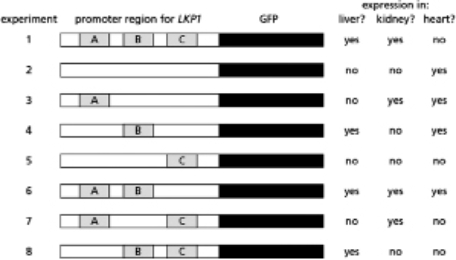Multiple Choice
You are interested in understanding the gene regulation of Lkp1, a protein that is normally produced in liver and kidney cells in mice.Interestingly, you find that the LKP1 gene is not expressed in heart cells.You isolate the DNA upstream of the LKP1 gene, place it upstream of the gene for green fluorescent protein (GFP) , and insert this entire piece of recombinant DNA into mice.You find GFP expressed in liver and kidney cells but not in heart cells, an expression pattern similar to the normal expression of the LKP1 gene.Further experiments demonstrate that there are three regions in the promoter, labeled A, B, and C in Figure 8-16, that contribute to this expression pattern.Assume that a single and unique transcription factor binds each site such that protein X binds site A, protein Y binds site B, and protein Z binds site C.You want to determine which region is responsible for tissue-specific expression, and create mutations in the promoter to determine the function of each of these regions.In Figure 8-16, if the site is missing, it is mutated such that it cannot bind its corresponding transcription factor.  Figure 8-16
Figure 8-16
Which of the following proteins are likely to act as gene activators?
A) factors X and Y
B) factors X and Z
C) factors Y and Z
D) factor X only
Correct Answer:

Verified
Correct Answer:
Verified
Q19: The owners of a local bakery ask
Q20: The MyoD transcriptional regulator is normally found
Q21: For each of the following sentences,
Q22: A neuron and a white blood cell
Q23: The gene for a hormone necessary for
Q25: Which of the following statements about RNAi
Q26: MicroRNAs<br>A)are produced from a precursor miRNA transcript.<br>B)are
Q27: In the absence of glucose, E.coli
Q28: Which of the following statements about DNA
Q29: Which of the following statements about the